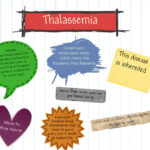News & Events
Major and Intermediate Syndromes of Thalassemia
Beta-thalassemia
Beta-thalassemia is characterized by:
· Mutations in the beta globin gene
· Severe anemia beginning from early childhood
· It can be identified at birth by screening for sickle-cell disease
Beta-thalassemia requires:
· Long-term transfusions
· Iron chelation therapy
· Hematopoietic stem cell transplantation (the only curative solution)
Alpha-thalassemia
· More complex than beta-thalassemia
· More widespread globally than beta-thalassemia
· Moderate anemia, allowing patients to live a somewhat normal life
· Little or no need for transfusions
· Exceptional long-term transfusions
Treatment
· Red blood cell transfusion
· Iron chelation treatment after 10 to 20 transfusions
· Deferiprone is indicated when DFO treatment is counter-indicated
· Splenectomy is indicated in case of hypersplenism or for lowering transfusion requirements
Therapeutic Education
· Learning self-infusion of medicine
· Physical exercise
· Adequate sun exposure
· Smoking cessation
· Following nutritional rules

